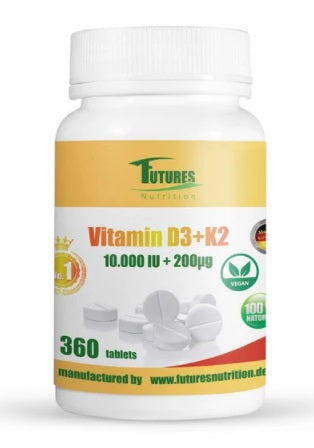
Why is vitamin D3 good?
Share
Is Vitamin D3 good for?
The minerals calcium and phosphate, which receive our bones, teeth and muscles healthy, are better controlled by vitamin D. The amount Vitamin DOur body needs can often be covered solely through sunlight. A vitamin D supplement is necessary if the sun does not seem, and it can be difficult to achieve the recommended daily dose alone about the food. It is important because the health benefits of vitamin D may be more important than accepted.
Why are the vitamins K2 and D3 good?

D3 and K2 Have recently drawn attention to the public and science because of their synergistic effects. It is becoming increasingly clear that the shared intake of these two vitamins has a positive synergy effect on general health.
Vitamins A and D are fat-soluble and activate joint proteins that help the body at calcium digestion. D3 increases calcium intake while K2 determines how calcium is recycled.
Vitamin D can escape your bone calcium if you do not absorb enough food or dietary supplements. As a result, promoting Vitamin K2 The bone salary. It regulates and reduces the harmful effects of calcification and hardening of soft tanks and thus prevents the degradation of bones (eg on the walls of blood vessels or around the most important organs). Osteoporosis and other chronic diseases such as renal or heart disease can be mitigated by combining these two vitamins, with further studies needed in this area.
What is vitamin D3 suitable for?
Vitamin D and Vitamin K are fat-soluble minerals required for good health. If you are taken with bold, you can be easily included in the bloodstream and can be found more frequently in fatty diet. Vitamin D is supplied by fish and oil as well as solar radiation, but is also a nutrient that the skin itself produces.

Calcium recording and calcium levels in the blood are two of the most important tasks of vitamin D, which both supports it. Some fatty animal products such as egg yolks, liver and cheese contain vitamin K. This vitamin is included in leafy vegetables and fermented sleeve fruits and vegetables. It helps with blood clotting and promotes the mineralization of bones and teeth. One of his main tasks is to keep the calcium level in the blood stable.
There are two ways to use vitamin D2 to achieve this goal:
Improvement of calcium recording:
D helps the body to better accommodate the calcium from food.
Removal of calcium from the bones:
If you do not take enough calcium with the food, your body uses calcium from the bones to keep your vitamin D mirror stable. This is important to keep the calcium levels in the blood at a healthy level. However, the role of calcium in the body goes far beyond its participation in the bones.
With a lack of calcium the body has no other choice but to resort to the stored in the bone calcium. In the long term this can lead to bone loss and osteoporosis.
Vitamin d3 + k2 10000I.E, vitamin d3 50.000iu

Vitamin D supplementation was the subject of numerous examinations to determine if it has detrimental effects in different doses. Heaney et al. No harmful effects reported healthy patients who received 836, 5500 or 10,000 IU / day. In the group of 5,500 ie / day, the serum levels of vitamin D increased by 28.1 to 64 ng / ml within five months, while the group with 10,000 ies / day increased to 88 ng / ml. According to research, 25 (OH) D-serum levels over 240 ng / ml are required to cause clinically significant hypercalemia; Therefore, an upper Consumption limit of 10,000 Units recommended per day.
Vitamin D3 units
There are no reports of 25 (OH) D-serum levels that exceed 10,000 IE / day 200 ng / ml. In two studies, 4,000 ie / day vitamin D3 were administered for one year, and the average 25 (OH) D-concentrations in the blood were 66ng / ml or 67ng / ml or 67ng / ml. The supplementation of 50,000 units Vitamin D3 There were no unwanted side effects per week. A D3 therapy of 50,000 units / week in a cohort of Statin-intolerant persons with low initial value of vitamin D in the blood (32 ng / ml) did not significantly changing the calcium levels nor EGFR. Patients with a vitamin D blood mirror of at most 4 percent of the upper standard range (100 ng / ml) showed no hypervitaminose D defined as a mirror of at least 150 ng / ml.
